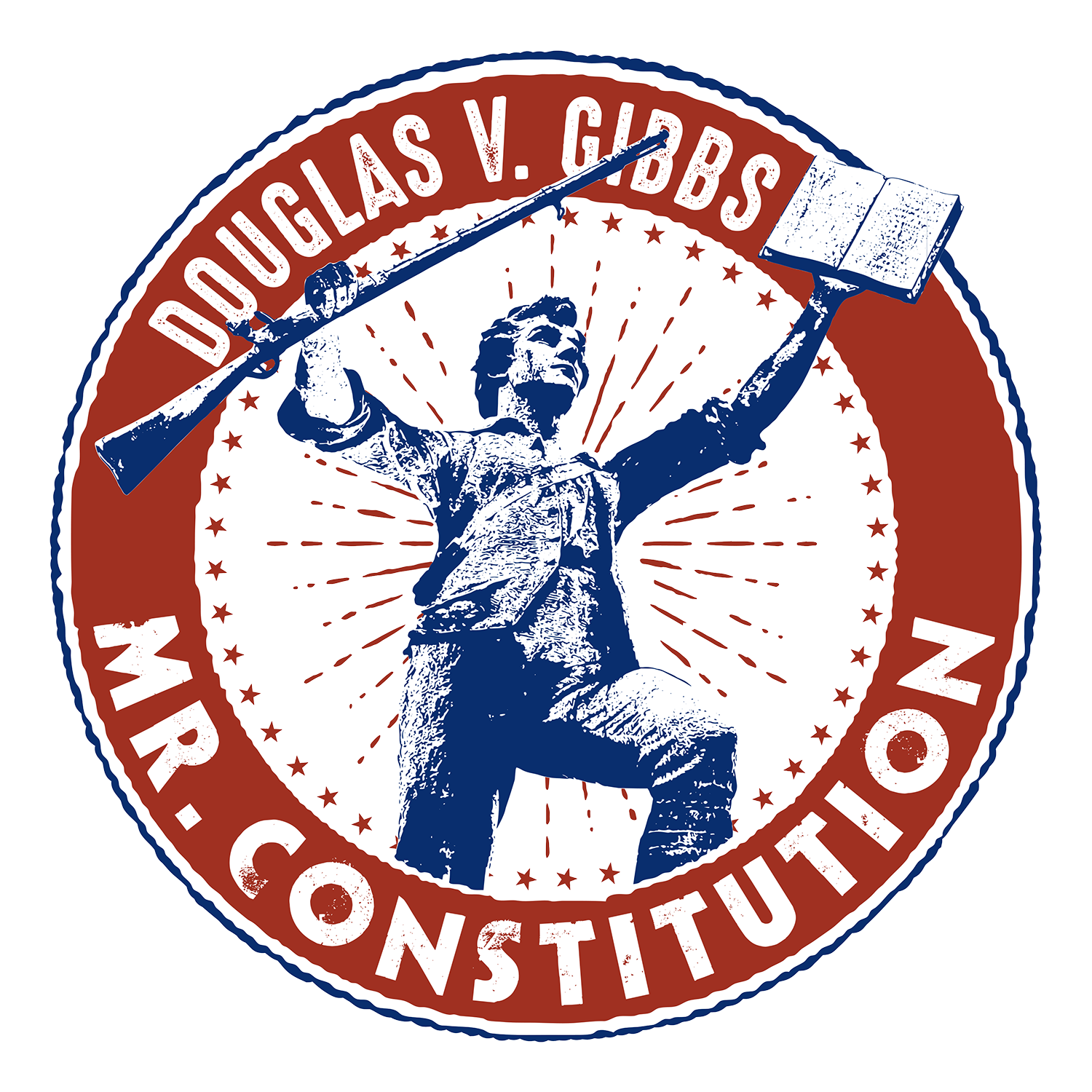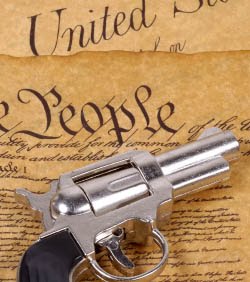By Douglas V. Gibbs
In court cases that make it to the United States Supreme Court, an argument you might sometimes hear is “common use.” The term basically begs to ask the question, “which firearms are considered covered by the Second Amendment?” An originalist like me might laugh at the fact that the question is asked in the first place. But, the reality is, it is a long-standing question.
Regarding the Second Amendment, the common use question basically asks, “Which firearms are protected by the Constitution?” And if you dig further, the question becomes, “In the Second Amendment what does the clause refer to with the word arms?” Does it include stun guns? Martial Arts hand weapons? Bladed weapons?
The 1828 Webster’s Dictionary, which is the first American English-Language Dictionary, and the one closest to the era of the Founding Fathers, defines “Arms” as being:
- (1) Weapons of offense or armor for defense and protection of the body.
- (4) In law, arms are any thing which a man takes in his hand in anger, to strike or assault another.
- (*) Sire arms are such as may be charged with powder, as cannon, muskets, mortars, etc.
So, from a resource point of view from the era the right to keep and bear arms as articulated in the Second Amendment includes all weapons and equipment that may be used for offense or defense including protective tools or apparatus. So, using those definitions the common use argument is an unconstitutional one. Using the term “arms” in the Second Amendment means anything that falls within those criteria:
- Guns of any kind
- Blades of any kind
- Other weapons including stun guns, pepper spray, etc.
- Protective devices like body armor or shields.
During congressional debates and the state ratification conventions the discussions regarding the Second Amendment never specifically listed what kinds of weapons were covered by the language of the Second Amendment. James Madison introduced the amendment to the House of Representatives, and while no specific weapons were discussed, what was discussed was the importance of preserving the right to keep and bear arms primarily for the purpose of preserving the ability of the militia to fight tyranny. Madison and others equated an armed populace as being a safeguard against standing armies that may be used by a potentially tyrannical federal government. If the purpose of the right to keep and bear arms is specifically so that citizens may serve as guards against federal tyranny (necessary to the security of a free state) then one could presume that means all citizens must have arms comparable to those of a soldier – not just hunting weapons.
The Ratifying Conventions in each of the States experienced similar discussions:
- Virginia Ratifying Convention
- George Mason warned against disarming the people: “To disarm the people is the best and most effectual way to enslave them.” Mason would also later comment, when asked who the militia is, “They consist now of the whole people, except a few public officers.”
- The discussion assumed that the people would have military-grade arms suitable for militia service.
- The proposed amendments from Virginia to the Second Amendment explicitly referred to the militia and private arms.
- Pennsylvania Ratifying Convention
- The minority report proposed language that concentrated on self-defense and militia roles.
- New York Ratifying Convention
- Declared that the militia should always be armed and that the people had the individual right to keep arms at home.
Not a single discussion limited arms to specific weapons or used a common use style argument. And, no debate stated that the Second Amendment was limited to arms need for militia use, or personal self-defense, or personal use for other reasons. The firearms protected by the Second Amendment, then, would include all weapons, including those in common military use at the time. Or as Ted Nugent once said, “The Second Amendment does not exist in case the deer rise up.” The scary weapons being labeled as assault rifles by opponents of gun ownership also are included when it comes to our right to keep and bear arms.
During the Constitutional Convention in 1787, and the debates regarding the Articles of Confederation less than a decade before, while the discussion of firearms did not directly land on the chamber floor, they were discussed indirectly when they discussed the militia concept. The militia, in fact, was a central discussion and was understood as being the body of the people armed with common military arms of the day.
Today’s judicial yardstick regarding allowable guns, however, includes the “common use test.” Under that standard courts seek to determine whether a weapon is in common use by law-abiding citizens for lawful purposes. According to the politicians and the general attitude of the courts is that even in common use, weapons can still be regulated where they are determined to be “dangerous and unusual.”
The argument is a modern one that emerged long after the ratification of the Second Amendment. Such an argument was never uttered during the debates over the Second Amendment, nor any of the discussions regarding the importance of the militia which includes every American Citizen capable of keeping and bearing arms. If the purpose of the Second Amendment is to secure the right to keep and bear arms because the use of those firearms are necessary to secure the freedom we have, then that means the common use argument is unconstitutional. Our right to keep and bear arms, if it is necessary to defend us against improper use of federal authority, must include weapons of war – the very firearms that those who oppose the private ownership of guns in our society are trying to (and in many cases have succeeded in) ban through federal law.
Shall not be infringed is definitive language. It means that every single federal gun law is unconstitutional. The federal government is the potential tyranny, so how is it they should be allowed to dictate to us what we can own, how we carry our arms, and that we must get a background check before we can even be considered as a potential purchaser of any firearms?
Then we have to ask, at what point does federal intrusion into our lives trigger the use of our right to keep and bear arms? The Declaration of Independence says, after all, we not only have the right to overturn government if it becomes tyrannical, but we have the duty to do so. The problem is, the argument to stand against the government can be patriotic or insurrection depending on who you are talking to. Conservatives will argue that the government under Biden was the kind that must be pushed back against. Democrats and their allies argue that the Trump Administration is lurching toward authoritarianism, and the use of National Guard personnel to assist ICE, or to clean up Washington D.C. is a clear sign of the federal government’s use of a standing army against the American People.
The Constitution gives us a clear picture of where the boundary lies.
According to Article I, Section 8 of the United States Constitution the federal government may use the militia for:
- Executing federal law domestically
- To quell insurrection
- To repel invasion
And according to Article IV., Section 4:
- To guarantee a State maintains a republican form of government
- To protect States from invasion
- With approval by the State legislature, or Governor when the legislature cannot convene, to quell domestic violence (which would include rioting and general criminal activity).
The right to keep (own/have) and bear (carry, including concealed carry based on the 1828 Webster Dictionary’s definition of the word bear), therefore, according to the Founding Fathers exists for citizens for personal protection, property protection, hunting, and participating in standing against a tyrannical government when the government exceeds its constitutional limitations and only a use of arms can remedy the situation. The Declaration of Independence warns us, however, not to do such things lightly. “Prudence, indeed, will dictate that Governments long established should not be changed for light and transient causes.”
The arguments being launched currently during Donald Trump’s second presidential term claims the federal government has crossed those constitutional lines, and that Trump’s Administration is the epitome of a dictatorial government, and that it even enters the realm of fascism. So, let’s look at those current arguments regarding whether or not the current federal government under President Trump is remaining within constitutional limitations:
- Use of National Guard to assist ICE.
- Article I, Section 8 allows the use of the militia to “execute the Laws of the United States.”
- Use of National Guard to clean up Washington D.C.
- Washington D.C, is a federal property and the President has the authority to use the militia to protect federal properties.
- Use of National Guard in cities for purposes other than executing federal law.
- The use of the militia in municipalities that lie within State territory to protect federal properties are constitutionally allowed.
- The use of the militia in cities to clean up crime in a manner like it is being used in Washington D.C. would require, according to Article IV., Section 4, approval of the State’s legislature, or the Governor, if the legislature is unable to convene. The city has no say in the matter.
So, while I agree we must “keep our powder dry” whenever dealing with the federal government and its potential tyranny, no matter who is in office, and we have the right to keep and bear any firearm or weapon as per our Natural Right to keep and bear arms, we are to be:
- Responsible and prudent with that right.
- Recognize the government’s role in our lives and not jump to potentially dangerous conclusions just because we ideologically disagree with the politicians in charge.
- Due to our responsibility to preserve and protect our republic, we have the right to be armed with weapons that are equal to or exceed the federal government’s weapons. The Federal Government can make no law limiting the ownership of our firearms. That said, as James Madison indicates in Federalist Paper #45, our Natural Rights are a local issue, so if any laws do need to be made regarding firearm ownership, those laws may be made at the State level – but even the States are required to recognized the right to keep and bear arms is a Natural Right and there is a line they are not supposed to cross. And it is our responsibility to hold them accountable and make sure they don’t cross that line.
— Political Pistachio Conservative News and Commentary



